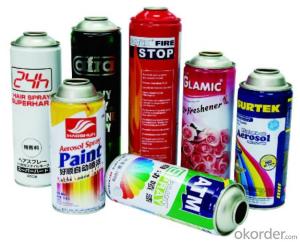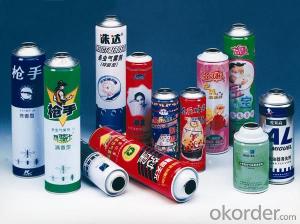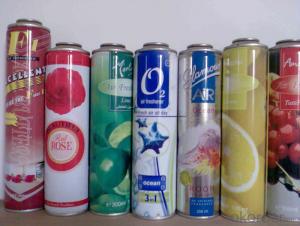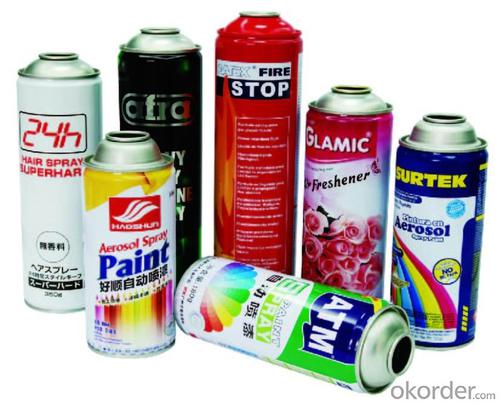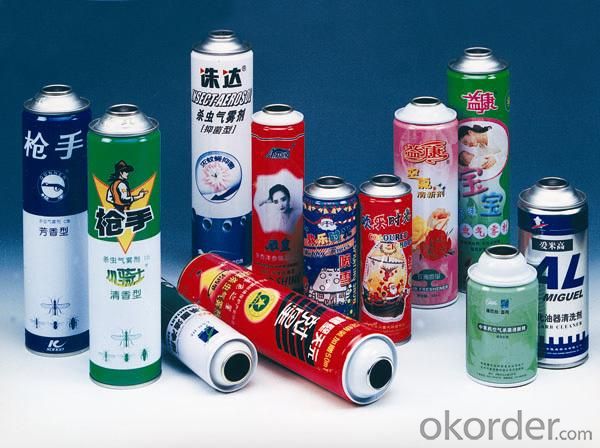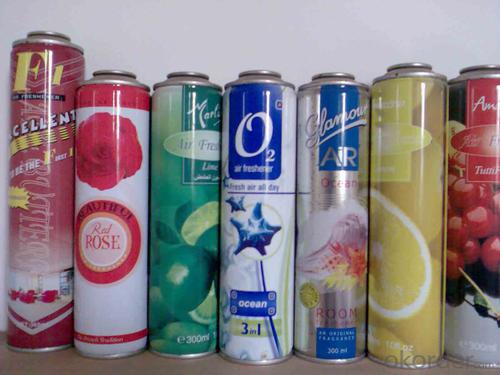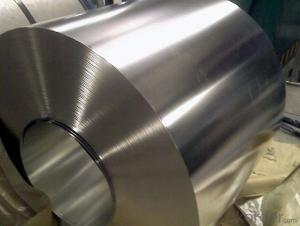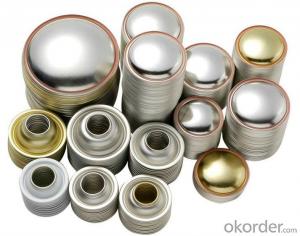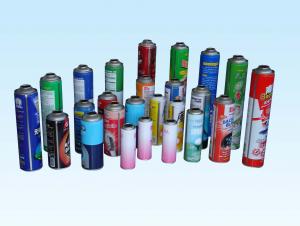Furniture Polish Aerosol Spray Can, Air Frenshner
- Loading Port:
- China main port
- Payment Terms:
- TT OR LC
- Min Order Qty:
- 50000 PCS
- Supply Capability:
- 30000000 PCS/month
OKorder Service Pledge
OKorder Financial Service
You Might Also Like
1. Detailed Specification
Diameter | 65mm |
Can height | 90-240mm |
Cone height | 13.5mm |
Thickness | 0.19/0.20mm as requested |
Printing | CMYK/Plain/White/as requested |
Internal | Golden/Plain/as requested |
Deliver time | With 15 days after receiving the deposit |
Opening internal/Opening external | 25.4±0.1mm/31.20±0.15mm |
Bursting pressure/deformation | >1.5mpa/1.3mpa |
2. Appearance Specifications
Diameter(mm) | Type | Height(mm) |
45mm | Necked-in | 95~220 |
52mm | Necked-in | 95~260 |
57mm | Necked-in | 100~240 |
60mm | Necked-in | 100~240 |
60mm | Straight | 100~240 |
65mm | Necked-in | 100~300 |
65mm | Straight | 100~240 |
3.Usage:
suitable for insecticide, air freshener, body spray, lighter refill, car care etc
4.Packing
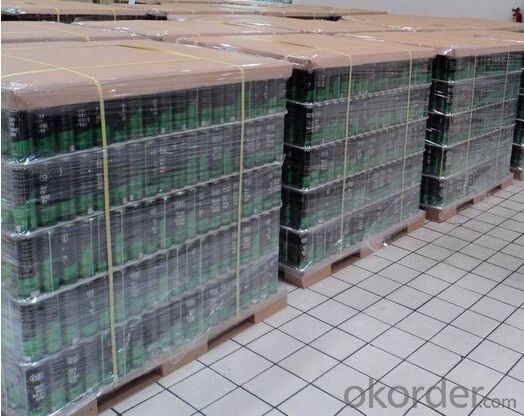
5.FAQ
1. Delivery Time:15-25 days, time can be shorten upon customer’s situation
2. Productivity:1,000,000 Cans/Day; 500,000 Printing Sheets/Day
3. MOQ:50,000pcs, but finally upon your size
4. Payment Term: 30% TT in advance, 70% balance against BL copy; 100% by LC at sight
- Q: What are the main applications of tinplate in the telecommunications industry?
- Tinplate is commonly used in the telecommunications industry for the manufacturing of various components such as antennas, connectors, and shielding materials. Its corrosion-resistant properties make it ideal for ensuring optimal signal transmission and durability in these applications. Additionally, tinplate's ability to provide electromagnetic interference (EMI) shielding helps to prevent signal distortion and maintain the integrity of telecommunications systems.
- Q: What are the main applications of tinplate in the gardening industry?
- Tinplate is commonly used in the gardening industry for various applications such as plant pots, seed trays, watering cans, and garden tools. The use of tinplate ensures durability, corrosion resistance, and ease of maintenance, making it an ideal choice for these gardening essentials. Additionally, tinplate can also be utilized for packaging purposes, such as cans for storing fertilizers, pesticides, and other gardening products.
- Q: What are the main applications of tinplate in the pharmaceutical industry?
- Tinplate is primarily used in the pharmaceutical industry for packaging purposes. Its main applications include the production of tinplate cans, containers, and closures. These tinplate packaging solutions provide a reliable and durable barrier against moisture, light, and oxygen, ensuring the protection and preservation of pharmaceutical products. Additionally, tinplate is also used for labeling and promotional purposes due to its excellent printability and aesthetic appeal.
- Q: Can tinplate packaging be used for industrial products?
- Yes, tinplate packaging can be used for industrial products. Tinplate is a durable and corrosion-resistant material that provides excellent protection for various industrial goods. It is commonly used for packaging industrial chemicals, paints, lubricants, and other similar products. The robustness and versatility of tinplate make it suitable for handling and transporting these items efficiently and safely.
- Q: How does tinplate compare to plastic-coated steel in terms of properties and applications?
- Tinplate and plastic-coated steel have different properties and applications. Tinplate is a thin, lightweight steel sheet coated with a layer of tin, which provides excellent corrosion resistance, solderability, and aesthetic appeal. It is commonly used in food and beverage packaging, as well as in the manufacturing of aerosol containers, electronic components, and various consumer products. On the other hand, plastic-coated steel is steel that is coated with a layer of plastic, typically through a process called extrusion. This coating enhances the steel's durability, impact resistance, and chemical resistance, making it suitable for applications that require protection against harsh environments or harsh handling. Plastic-coated steel is often used in construction, automotive, and electrical industries, where strength and corrosion resistance are crucial. In summary, tinplate is preferred for applications that require corrosion resistance, solderability, and a visually appealing finish, such as food packaging. Plastic-coated steel, on the other hand, is more suitable for applications that demand enhanced durability, impact resistance, and chemical resistance, like in construction or automotive industries.
- Q: Cookies with tinplate packaging has what advantage
- 1. good mechanical properties: tinplate cans relative to other containers, such as plastic, glass, paper containers and strength, and good rigidity, it is not easy to break. It is not only used for small sale packing, but also the main container for large transportation package. 2. excellent barrier: Tin than any other...
- Q: What are the main factors influencing the consumer preferences for tinplate packaging?
- The main factors influencing consumer preferences for tinplate packaging include its durability, recyclability, and ability to preserve the quality and freshness of products. Additionally, the aesthetics, brand reputation, and cost-effectiveness of tinplate packaging also play a significant role in shaping consumer preferences.
- Q: Can tinplate be painted?
- Yes, tinplate can be painted. Tinplate is commonly used in the production of cans and other packaging materials, and it is suitable for various coating processes, including painting. The surface of tinplate can be treated and primed before applying paint, ensuring good adhesion and durability of the painted finish.
- Q: What are the common challenges in recycling tinplate packaging?
- Some common challenges in recycling tinplate packaging include contamination from other materials, such as paper or plastic, which can make the recycling process more difficult and less efficient. Additionally, tinplate packaging often contains a plastic lining or coating, which must be removed before recycling the tinplate itself. Another challenge is that tinplate packaging is often small and lightweight, making it more prone to being lost or mixed in with other waste streams. Finally, there may be limited infrastructure or collection systems in place to effectively collect and recycle tinplate packaging.
- Q: How does tinplate contribute to the preservation of photographic equipment?
- Tinplate contributes to the preservation of photographic equipment by providing a durable and corrosion-resistant material for the construction of camera bodies and other components. This helps protect the sensitive internal mechanisms from external factors such as moisture, dust, and physical damage, thereby extending the lifespan of the equipment. Tinplate also helps maintain the overall aesthetic appeal of the equipment, as it can be easily coated or painted to enhance its appearance and protect it from scratches or wear.
Send your message to us
Furniture Polish Aerosol Spray Can, Air Frenshner
- Loading Port:
- China main port
- Payment Terms:
- TT OR LC
- Min Order Qty:
- 50000 PCS
- Supply Capability:
- 30000000 PCS/month
OKorder Service Pledge
OKorder Financial Service
Similar products
Hot products
Hot Searches
Related keywords
